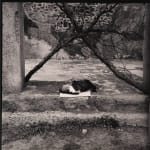Colette Álvarez Urbajtel
Comprehensive Archive of the Artist's Work, 1970s-90s
Silver (61), platinum (16) and chromogenic (45) prints
Most 8 x 10 inches, a few larger; some on exhibition mounts
Nearly all signed recto or verso, and most with titles and dates.
Nearly all signed recto or verso, and most with titles and dates.
Further images
-
(View a larger image of thumbnail 1
)

-
(View a larger image of thumbnail 2
)

-
(View a larger image of thumbnail 3
)

-
(View a larger image of thumbnail 4
)

-
(View a larger image of thumbnail 5
)

-
(View a larger image of thumbnail 6
)

-
(View a larger image of thumbnail 7
)

-
(View a larger image of thumbnail 8
)

-
(View a larger image of thumbnail 9
)

-
(View a larger image of thumbnail 10
)

This collection was acquired directly from the estate of Evelyne Daitz, Lee Witkin's successor at the pioneering Witkin Gallery. Witkin and Daitz maintained close relationships with Urbajtel, and her husband,...
This collection was acquired directly from the estate of Evelyne Daitz, Lee Witkin's successor at the pioneering Witkin Gallery. Witkin and Daitz maintained close relationships with Urbajtel, and her husband, photographer Manuel Álvarez Bravo. Throughout the years of their friendship and professional collaboration, the gallery published numerous books on their photographs, mounted various shows in the gallery, and helped to place their work in art institutions in the U.S. and Mexico. Both Witkin and Daitz were huge advocates of Urbajtel's vision, though it was primarily Evelyne who championed the introduction of her photographs to the market. Two exhibitions were held at the gallery in the 1990s, a decade which saw the photo-market in flux, welcoming new names to an already canonized roster. This rich and varied archive represents the breadth of photographer Colette Urbajtel's arresting oeuvre, from the 1970s when she worked as Manuel Álvarez Bravo's assistant and printer, through the 1990s when she began photographing in color.
The formats of the photographs are varied including 17 mounted exhibition silver prints, 44 unmounted and matted silver prints, 45 unmounted chromogenic prints, and 16 exquisite platinum prints. The varying nature of the formats is likely related to the process of editing for exhibitions and presentation, and we believe this to be the entirety of Urbajtel's work held by the gallery at the time of Evelyne Daitz's passing.
Colette Álvarez Urbajtel was a French-Mexican photographer known for her black and white photographs of the everyday. Married to the famed Manual Álvarez Bravo, her personal career, so closely concatenated with her husbands, often gets eclipsed by his success. However, Álvarez Urbajtel’s work has been recognized in with a longlist of exhibitions, two retrospectives, publications, and her work is contained in the collections of major institutions such as National Library of Paris, The Museum of Modern Art in New York, and the Museum of Modern Art in Mexico City.
While Álvarez Bravo’s work was tinged with spiritualism, Álvarez Urbajtel focused on natural composition and scenes of mundane life. Her photography had more optimistic vision, cutting parts of the image that did not align amicably. She worked in black and white for most of her career until 1990 when she began photographing in color.
Born in Paris in 1934, Urbajtel studied law in France before arriving in Mexico as an exchange student in 1959. While studying, her interest in photography grew. She married Manuel Álvarez Bravo and thrived under the tutelage of her husband and mentor. Urbajtel was Bravo’s longtime assistant and confidante during the height of his career until his death – all the while maintaining her own career in photography.
More photos available upon request.
The formats of the photographs are varied including 17 mounted exhibition silver prints, 44 unmounted and matted silver prints, 45 unmounted chromogenic prints, and 16 exquisite platinum prints. The varying nature of the formats is likely related to the process of editing for exhibitions and presentation, and we believe this to be the entirety of Urbajtel's work held by the gallery at the time of Evelyne Daitz's passing.
Colette Álvarez Urbajtel was a French-Mexican photographer known for her black and white photographs of the everyday. Married to the famed Manual Álvarez Bravo, her personal career, so closely concatenated with her husbands, often gets eclipsed by his success. However, Álvarez Urbajtel’s work has been recognized in with a longlist of exhibitions, two retrospectives, publications, and her work is contained in the collections of major institutions such as National Library of Paris, The Museum of Modern Art in New York, and the Museum of Modern Art in Mexico City.
While Álvarez Bravo’s work was tinged with spiritualism, Álvarez Urbajtel focused on natural composition and scenes of mundane life. Her photography had more optimistic vision, cutting parts of the image that did not align amicably. She worked in black and white for most of her career until 1990 when she began photographing in color.
Born in Paris in 1934, Urbajtel studied law in France before arriving in Mexico as an exchange student in 1959. While studying, her interest in photography grew. She married Manuel Álvarez Bravo and thrived under the tutelage of her husband and mentor. Urbajtel was Bravo’s longtime assistant and confidante during the height of his career until his death – all the while maintaining her own career in photography.
More photos available upon request.









